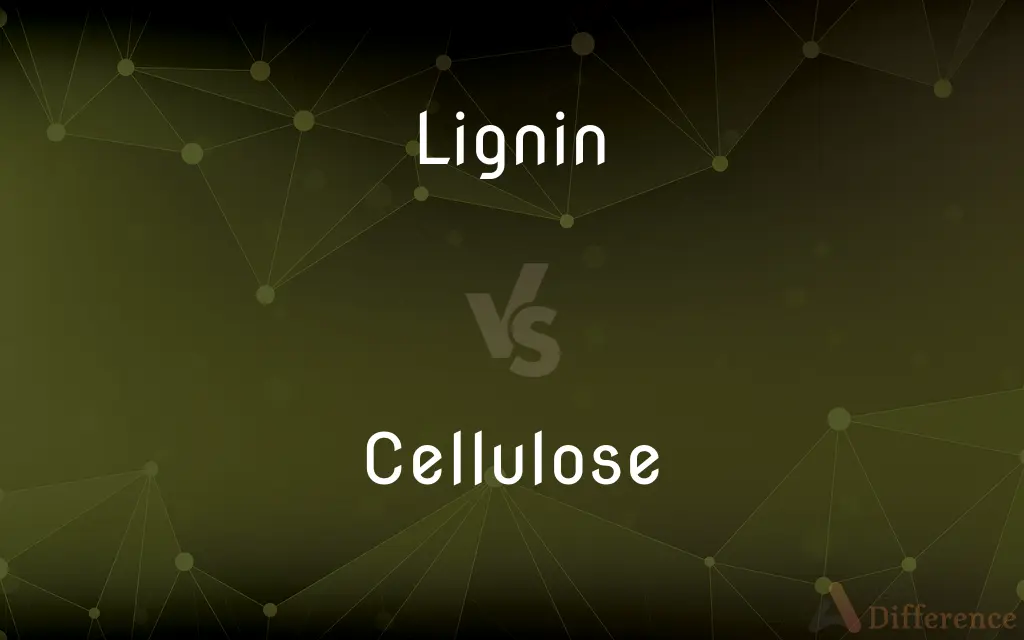Lignin vs. Cellulose — What's the Difference?
By Urooj Arif & Maham Liaqat — Updated on March 20, 2024
Lignin is a complex organic polymer in plants, adding rigidity, while cellulose is a carbohydrate forming plant cell walls, crucial for structure.

Difference Between Lignin and Cellulose
Table of Contents
ADVERTISEMENT
Key Differences
Lignin is an intricate organic polymer found in the cell walls of many plants, contributing to their rigidity and woodiness, whereas cellulose is a polysaccharide consisting of glucose units, playing a vital role in the structural integrity of plant cell walls.
Lignin acts as a natural glue, providing plants with structural support and water-conducting properties, whereas cellulose provides tensile strength, crucial for the plant's overall structure and growth.
Lignin's complex, amorphous structure makes it less digestible by most microorganisms, contributing to the carbon cycle's slowness, while cellulose, with its linear and crystalline structure, is more readily broken down by cellulases, albeit still challenging due to its strong hydrogen bonds.
Lignin content varies significantly among different plant species, influencing the ease of paper production and biomass processing, whereas cellulose is more uniformly present in plant cell walls, being the most abundant organic polymer on Earth.
While lignin removal is a key step in the papermaking process, enhancing the quality and brightness of paper, cellulose serves as the primary raw material, providing the necessary fibers for paper production.
ADVERTISEMENT
Comparison Chart
Composition
Complex organic polymer
Polysaccharide of glucose units
Role in plants
Provides rigidity, structural support, and water conduction
Offers tensile strength and structural integrity
Structure
Amorphous and complex
Linear and crystalline
Digestibility
Resistant to most microorganisms due to complexity
Digestible by cellulases, though challenging due to strong hydrogen bonds
Industrial use
Removed in papermaking for better quality; used in biofuels and materials
Primary raw material for paper production and various cellulose-based products
Compare with Definitions
Lignin
Complex organic polymer contributing to plant rigidity.
Lignin adds strength to the woody parts of trees.
Cellulose
Polysaccharide consisting of glucose units, crucial for plant structure.
Cellulose fibers give plants their shape and strength.
Lignin
Varied content across plant species affects biomass processing.
High lignin content in some plants makes them less suitable for papermaking.
Cellulose
Primary component of plant cell walls, providing tensile strength.
The cellulose in cotton fibers makes them strong and durable.
Lignin
Provides structural support and water conduction in plants.
Lignin's presence in the vascular tissues aids in water transport.
Cellulose
Most abundant organic polymer on Earth, found in all plant cell walls.
Cellulose's abundance makes it a key resource for various industries.
Lignin
Resistant to microbial digestion, affecting the carbon cycle.
Lignin decomposition is slow, contributing to carbon sequestration in forests.
Cellulose
Main raw material in paper production and cellulose-based products.
Cellulose from wood pulp is transformed into paper and textiles.
Lignin
Used in biofuels and materials after removal from paper pulp.
Lignin by-products from paper mills can be utilized in making biofuels.
Cellulose
Broken down by cellulases, though with difficulty due to hydrogen bonds.
Some microorganisms can digest cellulose, releasing energy.
Lignin
Lignin is a class of complex organic polymers that form key structural materials in the support tissues of most plants. Lignins are particularly important in the formation of cell walls, especially in wood and bark, because they lend rigidity and do not rot easily.
Cellulose
Cellulose is an organic compound with the formula (C6H10O5)n, a polysaccharide consisting of a linear chain of several hundred to many thousands of β(1→4) linked D-glucose units. Cellulose is an important structural component of the primary cell wall of green plants, many forms of algae and the oomycetes.
Lignin
A complex polymer, the chief noncarbohydrate constituent of wood, that binds to cellulose fibers and hardens and strengthens the cell walls of plants.
Cellulose
A polysaccharide, (C6H10O5)n, that is composed of glucose monomers and is the main constituent of the cell walls of plants. It is used in the manufacture of numerous products, including paper, textiles, pharmaceuticals, and insulation.
Lignin
(organic compound) A complex non-carbohydrate aromatic polymer present in all wood.
Cellulose
A complex carbohydrate that forms the main constituent of the cell wall in most plants and is important in the manufacture of numerous products, such as paper, textiles, pharmaceuticals, and explosives.
Lignin
A substance characterizing wood cells and differing from cellulose in its conduct with certain chemical reagents.
Cellulose
(organic compound) A polysaccharide containing many glucose units in parallel chains.
Lignin
A complex polymer; the chief non-carbohydrate constituent of wood; binds to cellulose fibers to harden and strengthen cell walls of plants
Cellulose
Consisting of, or containing, cells.
Cellulose
Consisting of, or containing, cells.
Cellulose
The substance which constitutes the essential part of the solid framework of plants, of ordinary wood, cotton, linen, paper, etc. It is also found to a slight extent in certain animals, as the tunicates. It is a carbohydrate, (C6H10O5)n, isomeric with starch, and is convertible into starches and sugars by the action of heat and acids. When pure, it is a white amorphous mass. See Starch, Granulose, Lignin.
Unsized, well bleached linen paper is merely pure cellulose.
Cellulose
A polysaccharide that is the chief constituent of all plant tissues and fibers
Common Curiosities
What is cellulose?
Cellulose is a carbohydrate, a polysaccharide consisting of glucose units, and is a primary component of plant cell walls.
How do the structures of lignin and cellulose differ?
Lignin has a complex, amorphous structure, while cellulose is characterized by a linear, crystalline formation.
How does lignin affect the papermaking process?
Lignin needs to be removed during the papermaking process to enhance paper quality and brightness, as it can cause paper to yellow and weaken over time.
What makes cellulose an abundant organic polymer?
Cellulose is the most abundant organic polymer on Earth because it is a fundamental component of the cell walls in all plants.
What is lignin?
Lignin is a complex organic polymer that adds rigidity and structural support to plants, particularly in wood and bark.
How do lignin and cellulose differ in their role in plants?
Lignin provides plants with structural support and rigidity, whereas cellulose gives tensile strength and maintains the structural integrity of cell walls.
Why is lignin considered more complex than cellulose?
Lignin has an amorphous and complex structure, making it less digestible and more chemically diverse than the linear and crystalline structure of cellulose.
What are some industrial uses of lignin?
Lignin is used in the production of biofuels, materials, and as a by-product in papermaking, where it is often burned for energy.
What is the significance of lignin's variability among plant species?
The variability in lignin content among plants affects their suitability for papermaking and biomass processing.
Why is cellulose important in the paper industry?
Cellulose serves as the primary raw material for paper production, providing the necessary fibers for paper and other cellulose-based products.
What role does cellulose play in textiles?
Cellulose is the primary component of natural fibers like cotton and linen, making it crucial for the textile industry.
Can both lignin and cellulose be digested by microorganisms?
While some microorganisms can break down cellulose using cellulases, lignin is much more resistant to microbial digestion due to its complex structure.
How does the digestibility of lignin and cellulose affect the environment?
Lignin's resistance to degradation slows down the carbon cycle, whereas cellulose is more readily broken down, albeit still challenging.
What challenges does lignin present in biomass conversion and biofuel production?
The complex nature of lignin poses challenges in its removal and conversion, impacting the efficiency of biomass conversion and biofuel production processes.
How does the structure of cellulose contribute to its functions?
The linear and crystalline structure of cellulose contributes to its strength and ability to form strong hydrogen bonds, essential for plant cell wall integrity.
Share Your Discovery

Previous Comparison
Encryption vs. Cryptography
Next Comparison
Nostalgia vs. MelancholyAuthor Spotlight
Written by
Urooj ArifUrooj is a skilled content writer at Ask Difference, known for her exceptional ability to simplify complex topics into engaging and informative content. With a passion for research and a flair for clear, concise writing, she consistently delivers articles that resonate with our diverse audience.
Co-written by
Maham Liaqat















































